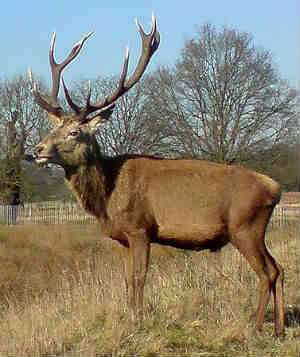Deer Hybrids
Family Cervidae
Mammalian Hybrids
Note: Deer hybrids are extremely common, and a variety of deer hybrid zones exist around the world.
Note: In Europe, Alces alces is referred to by the common name elk, whereas in North America the common name used is moose. A. alces is divided into two main types, western and eastern, which have a hybrid zone in the Yenisei River valley and Altai Mountains (central Siberia). Lister 2005.
Alces alces [Moose | Elk] (2n = 70)
× Bos taurus (♀) [European Domestic Cattle] CON: northern North America, northern Eurasia. See the separate article “Moose × Cow.”
× Cervus elaphus (♀?) [Red Deer | Elk | Wapiti] NHR? CON: northern North America, northern Eurasia. See the separate article “Moose × Red Deer hybrids.”
× Equus caballus (♀) [Domestic Horse] See the separate article "Moose × Horse."
× Odocoileus hemionus [Mule Deer] Photos of ostensible hybrids of can be viewed here.
|
|
|
Axis deer (Axis axis) |
Axis axis [Axis Deer]
× Axis porcinus (↔ usu. ♂) [Hog Deer] CHR. HPF. CON: India. Backcrosses to A. axis have been reported. The cross has occurred in both directions. McMaster (1871, p. 113) describes a young hybrid female produced in an Indian zoo as being of a darker color than her axis deer father and with fainter spots. He also said she “carries her head low like her porcine mother and thus runs with the back apparently much arched. The ears struck me as being larger than those of a spotted fawn of about the same age or size.” Gray says one hybrid resembled A. porcinus "in head, face and horns." Dathe 1966†; Gray 1971 (p. 150); International Zoo Yearbook 1966 (p. 400), 1967 (p. 318), 1968 (p. 307), 1969 (p. 236); 1977 (p. 324); Rörig 1903.
× Cervus duvaucelii [Swamp Deer | Barasingha] CHR. CON: Pakistan, India? International Zoo Yearbook 1970 (p. 271). See also: Axis axis × Cervus nippon.
× Cervus elaphus (♀) [Red Deer | Elk | Wapiti] Some authors (e.g., Gray 1972, p. 150) list this cross on the basis of reports that refer to “Spotted Deer” a common name used for both A. axis and Cervus nippon. The hybrids in question in such reports are usually Cervus elaphus × C. nippon (q.v.). However, Röse (1869, pp. 199-200) does report this cross and gives details. The parents were raised together and produced four hybrids, three stillborn, from four pregnancies. The fourth pregnancy was unusual in that the red deer mother was impregnated both by the Axis mate as before, but also by a C. elaphus stag. After an eight-month gestation, the mother gave birth to a dead hybrid calf, but one month later, a healthy, pure red deer calf was born. The single, viable hybrid calf reached adulthood.
× Cervus nippon [Sika Deer] A hybrid resulted when an axis deer and a sika crossed on the estate of the President of India. This hybrid doe then crossed to a buck swamp deer at the New Delhi Zoo. The resulting hybrid doe resembled a swamp deer. International Zoo Yearbook (1972, p. 336).
× Cervus timorensis (♂) [Rusa] CHR. DRS. The Paris menagerie (Jardin des Plantes) had a hybrid in 1840. Geoffroy Saint-Hilaire 1840.
× Cervus unicolor [Sambar] NHR? Gono Semiadi (pers. comm. to the IUCN, 2006; Intenet Citations: SAMBA, accessed June 3, 2012) says hybridization is probably occurring in Sumatra between the sambar and the introduced axis deer.
× Dama dama [Fallow Deer] The Bartlett Society website (tinyurl.com/hey3grd; accessed July 12, 2012) lists this cross, citing Bennett (1835, p. 256), who says, “it is even stated on the authority of Peter Collinson that a mixed progeny has been obtained between them [i.e., axis deer] and the Fallow-Deer.” However, Bennett, writing in the first half of the 19th century, uses the name “Fallow-Deer” (and, in several places, “Virginia Fallow-Deer”) which has to be interpreted as Odocoileus virginianus, not Dama dama.
× Hemitragus jemlahicus (♂) [Himalayan Tahr | Jharal] CHR. See the separate article "Himalayan Tahr × Axis Deer hybrids."
+ Muntiacus muntjak [Indian Muntjac] Buffon (1827, p. 174) reported no hybrids of this type, but he does mention that a male Indian muntjac shipped to Europe with a female axis deer was "tormented with desire to cover her, but was too small to succeed" ("Il y avait avec lui une femelle d'axis qu'il tourmentait beaucoup pour la couvrir mais il était trop petit pour y réussir.").
× Odocoileus virginianus (♀) [White-tailed Deer] CHR. DRS. See: Axis axis × Dama dama. Lantz 1910 (p. 23).
Note: The IUCN lists A. porcinus as endangered.
Axis porcinus [Hog Deer]
See also: Axis axis.
× Capreolus capreolus (♀) [Western Roe Deer] CHR. DRS. Two hybrids, one of each sex, were born at the Dresden Zoo on Mar. 3, 1862. They died eight days after birth (for unspecified reasons). Opel 1863 (pp. 65, 66).
× Dama dama(♀) [Fallow Deer] CHR. DRS. A hybrid was raised at Bloemfontein Zoo, South Africa. Gray 1971 (p. 151).
|
|
|
A female roe deer (Capreolus capreolus) |
Note: Capreolus is Latin for young roe-deer, wild goat or chamois.
Capreolus capreolus [Western Roe Deer] (2n = 70)
See also: Axis porcinus.
× Capra hircus (♀) [Domestic Goat] CHR?? In an extremely old and undetailed record, Bechstein (1801, p. 491) lists this cross and says the offspring blend the characters of the parents. Ackermann (1898, p. 66) also lists this hybrid (citing Weidmanns Feierabende, ein neues Handbuch für Jaeger und Jagdfreunde, 1819, p. 33). For more information about goats mating with roe deer, see the separate article "Roe Deer × Sheep"
× Capreolus pygargus (♂) [Eastern Roe Deer] CAEBHR. Parapatric contact zone (lower Volga basin, Russia). HPF(♂&♀). The hybrid zone is situated on the right bank of the Volga (Danilkin 1996). Most, but not all, F₁ males are sterile. In an evaluation of mixed pairs, C. pygargus males successfully fertilized C. capreolus females 50-60% of the time, but only about 20% of females impregnated in this way deliver unassisted live fawns (the hybrid fetuses are so large that either they or the mothers often die). Reciprocal matings did not occur (rutting C. capreolus males will not mount C. pygargus females). Sokolov and Gromov (p. 439) say some male hybrids are sterile. Danilkin 1986, 1995, 1996; International Zoo Yearbook 1970 (p. 273), 1971 (p. 284); Sokolov and Gromov 1985, 1990; Stubbe and Bruchholz 1980; Zernahle 1980.
× Ovis aries (♂) [Domestic Sheep] See the separate article “Roe Deer × Sheep.”
Note: Hybrid zones exist between three populations (mantschuricus, pygargus, tianschanicus) treated as races of Capreolus pygargus. Sokolov and Gromov 1990 (p. 442).
Capreolus pygargus [Eastern Roe Deer]
× Cervus elaphus (♀) [Red Deer | Elk | Wapiti] CHR. CON: northern Asia. Carl Hagenbeck (1909, pp. 216-219) produced this cross, which he says “gives very good results."
Cervus alfredi [Visayan Spotted Deer | Prince Alfred’s Deer]
× Cervus mariannus (♀) [Philippine Brown Deer] CHR. HPF(♀♀). CON: Philippines. Two hybrids were born in the London Zoo in 1871 and 1872. A female hybrid later backcrossed to a Cervus mariannus male. Ackermann 1898; Flower 1929a (p. 310); Zuckerman 1953.
Cervus duvaucelii [Swamp Deer | Barasingha]
See also: Axis axis.
× Cervus unicolor [Sambar] NHR?? CON: northern India. In a brief article, Mr. Frank Finn, Deputy Superintendent of the Indian Museum, opposes the opinion of Mr. David Ezra that an animal killed in the vicinity of Cooch Behar, India in the late 1800s was a probable hybrid of this type. Finn 1902.
Note: In Europe, Cervus elaphus is referred to by the common name “red deer,” whereas in North America the common names are “elk” or “wapiti.” These two deer have often been treated as separate species (Cervus canadensis in the New World and Cervus elaphus in the Old World), particularly since the publication of Pitra et al. (2004), but the two have often simply been lumped under the name Cervus elaphus. Hybrids of the two are fertile in both sexes (Flower 1929a, p. 317; Gray 1971, p. 152; Howard 1965; Lantz 1910; ; Rörig 1903; Seitz 1959a; von Knottnerus-Meyer 1904; Wodzicki 1950). Here, deer hybrids involving Cervus canadensis are listed under the name of Cervus elaphus.
Cervus elaphus [Red Deer | Elk | Wapiti] (2n = 68)
See also: Alces alces; Axis axis; Capreolus pygargus.
× Bos taurus (♀) [European Domestic Cattle] See the separate article “Cow × Red Deer hybrids.” Also see: Alces alces × Bos taurus.
× Cervus nippon (↔ usu. ♂) [Sika Deer] CAENHR(Ireland, Britain, Europe, New Zealand and eastern Asia). HPF(♂&♀). See the separate article “Sika × Red Deer Hybrids.”
× Cervus unicolor (♂ prob. ↔) [Sambar] CHR. Muir et al. artificially inseminated 400 red deer hinds with C. unicolor semen and 31 (8%) were pregnant at 40 days, and 24, at 100 days. Only four pregnancies were full term. A single female calf was born alive and reared. In the same study, ten sambar hinds were inseminated with C. elaphus semen, five (50%) were pregnant at 40 days, but none, at 100 days. Since the rate of initial impregnation was more than six times higher with the cross in the latter direction, it seems likely that a larger number of inseminations would have produced hybrid offspring. Long et al. (1998) showed that hybrids of this type can be identified by their rutting vocalizations and alarm calls alone. Harrington 1973 (citing Powerscourt); Muir et al. 1997; Powerscourt (Viscount) 1884 (p. 208).
× Dama dama [Fallow Deer] NHR? CON: western Eurasia. Hegendorf (1926) pictures an alleged wild-shot female hybrid. If this animal was actually a C. elaphus × D. dama hybrid, then it was partially fertile, since it had a calf with it when it was shot.
× Elaphurus davidianus [Père David’s Deer] CHR. HPF(♂&♀). CON: formerly, northern China. Three male F₁ hybrids sired 143 backcrosses with red deer females. Martin et al. (1974, p. 453) describe these deer hybrids as “endlessly fertile.” However, Fennessy and Mackintosh (1992) say hybridization attempts using artificial insemination were only 13% successful and were followed by a 40% embryo mortality rate, yielding only 8% full-term pregnancies. In an article on hybrids of this type, deer expert G. Kenneth Whitehead (1993, pp. 309-310) comments that "Despite the longer gestation period by approximately six weeks of the latter species [i.e., Père David’s Deer], there are several authentic recordings of successful hybridization between Red deer and Père David’s deer. Towards the end of the last century, as a result of such a union, a female Red/Père David hybrid was born at the Jardin d'Accimatation, Paris on 31 August 1900, and when she became six years of age, was transferred to Woburn where, although she associated with her own species [?], she bred with a Red deer stag, and I was informed by the late Duke of Bedford that her calves continued to show some traces of her Père David breeding." Whitehead has additional details about this cross. E. davidianus is extinct in the wild, but efforts are underway to reintroduce it to its native habitat. See also: Cervus elaphus × Panolia eldii. Asher et al. 1988; Fennessy and Mackintosh 1992; Fennessy et al. 1991; Flower 1929b (p. 318); Goosen 1997; Goosen et al. 1997, 1998, 1999; Jones and Manton 1983; Krzywinski 1993; Tate et al. 1992, 1995, 1997; Whitehead 1993.
× Equus caballus [Horse] See the separate article “Horse-deer hybrids.”
× Homo sapiens [Human] See the separate article “A Deer-human Hybrid?.”
× Odocoileus hemionus [Mule Deer] Ackermann (1898, p. 61) says this cross ("Cervus canadensis × C. mexicanus") occurred at the London Zoo on 9 Sept. 1865 and cites Zoologischer Garten (1873, p. 36). However, no red deer/mule deer hybrid appears in Flower's List of Vertebrated Animals exhibited in the Gardens of the Zoological Society of London, 1828-1927 (Flower 1929a), nor is it listed on the page that Ackermann cites. Cervus mexicanus is a synonym of Odocoileus hemionus mexicanus. A probable hybrid of this type, photographed in California in 2018, is pictured below. This animal was smaller than an elk and had antlers similar to those of a mule deer.
× Ovis aries [Domestic Sheep] Such a hybrid is described in a quoted passage toward the end of the separate article “Sheep/Mule Deer Hybrids.” In addition, Bronn (1847, p. 167) lists this cross, but he cites no sources.”
× Panolia eldii [Eld's Deer] On the basis of molecular data, Pitra et al. (2004) suggest that Elaphurus, the genus to which Père David’s Deer (Elaphurus davidianus) belongs, arose during the Pliocene as a product of this cross (see also Hassanin et al. 2012). Other deer, known from fossils but now extinct, have been treated as species of Elaphurus (Elaphurus formosanus, Elaphurus meziesianus, Elaphurus bifurcatus, and Elaphurus shikamai).
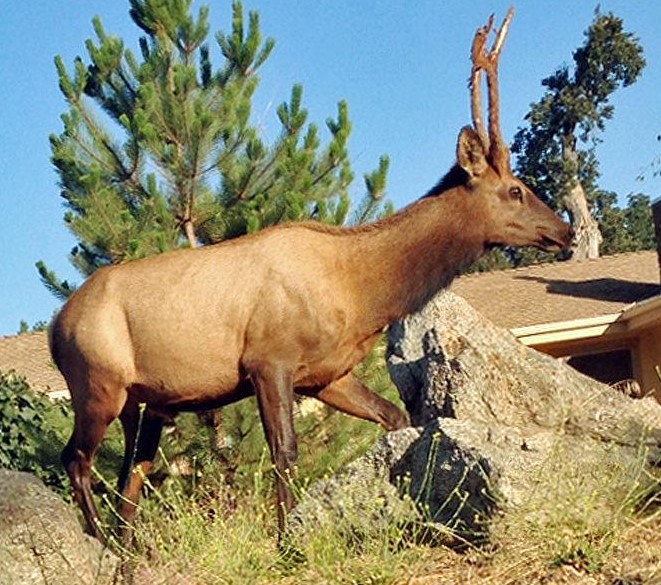 A probable elk/mule deer hybrid photographed by David Whitley in the Tehachapi Mountains in 2018 at Bear Valley Springs, which is about 15 miles southeast of Bakersfield, California. This photo is shown under an assumption of fair use.
A probable elk/mule deer hybrid photographed by David Whitley in the Tehachapi Mountains in 2018 at Bear Valley Springs, which is about 15 miles southeast of Bakersfield, California. This photo is shown under an assumption of fair use.
Cervus mariannus [Philippine Brown Deer] (nigricans) See: C. alfredi.
Note: Captive deer hybrids are known between two types (nippon, taiouanus) formerly treated as separate species, but now as races of C. nippon. International Zoo Yearbook 1973 (p. 339)
Cervus nippon [Sika Deer]
See also: Axis axis, Cervus elaphus.
× Cervus unicolor [Sambar] CHR. CON: southern China? A few sambar/sika deer hybrids were produced at Woburn in the U.K. (Whitehead 1993 p. 312).
+ Ovis aries (♂) [Domestic Sheep] In Kunming, China, at the Yunnan Wild Animal Park, a ram and a sika doe formed a mated pair and have been many times photographed mating with each other. Neither of these animals was interested in sexual partners of its own kind. See also the separate article "Roe Deer × Sheep." Internet Citations: SMACK
Cervus timorensis [Rusa]
See also: Axis axis.
× Cervus unicolor [Sambar] CHR. HPF(♂&♀). DRS. Deer hybrids of this type exhibit heterotic growth. At ten months of age, they are as heavy as pure R. timorensis at 20-24 months. Male hybrids produce offspring with C. timorensis females, but female hybrids produce offspring with C. unicolor males. Limited commercial production occurs. According to Gono Semiadi (pers. comm. to the IUCN, 2006; Intenet Citations: SAMBA) hybridization with the rusa is a conservation threat to the sambar, where it has been introduced into the sambar’s range in Pewajam District, East Kalimantan. Idris and Moin 2009; Leslie 2011 (p. 18); Slee 1984, 1985; Van Mourik and Schurig 1985. Internet Citations: RIRD, SAMBA.
Cervus unicolor [Sambar] (2n = 56)
See also: Axis axis; Cervus duvaucelii; C. elaphus; C. timorensis; C. unicolor.
× Odocoileus virginianus [White-tailed Deer] CHR. DRS. In correspondence with Brown published in The American Naturalist, Caton says that he produced a sambar/white-tailed deer hybrid, but gives no details. Brown and Caton 1880 (p. 396).
Dama dama [Fallow Deer]
See also: Axis axis, A. porcinus; Cervus elaphus.
× Dama mesopotamica (↔ usu. ♂) [Mesopotamian Fallow Deer] CHR. HPF. CON: possible contact near border of Turkey and Iraq? D. mesopotamica is designated as endangered. These deer hybrids are commonly produced for venison. Conception rates with cryopreserved semen are lower in mixed matings (50-60%) than in pure D. dama matings (60-70%). These taxa are sometimes lumped. Asher et al. 1993; Crandall 1964; Fletcher 2001; Flower 1929a (p. 308); Mylrea et al. 1991; Zuckerman 1953 (p. 893). Internet Citations: RIRD.
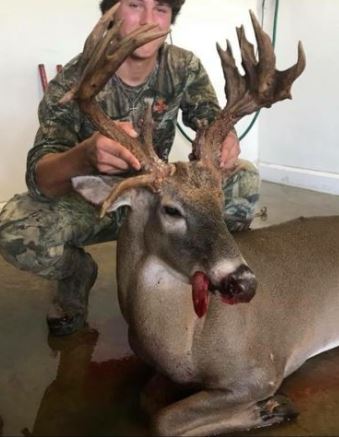 Buck with palmated antlers shot in Chesterfield County, South Carolina in 2017.
Buck with palmated antlers shot in Chesterfield County, South Carolina in 2017. Fallow deer antlers (left) and those of an ordinary white-tailed deer (right).
Fallow deer antlers (left) and those of an ordinary white-tailed deer (right).
× Odocoileus virginianus [White-tailed Deer] DRS. Shoemaker (1916, p.20) states that "In South Carolina there are frequent cases of palmation in the deer, due to some English fallow bucks liberated by planters in the Eighteenth Century." The only deer native to South Carolina is O. virginianus. Thus, Shoemaker's statement is tantamount to saying that the introduced fallow deer hybridized with native white-tails. Moreover, the trait being maintained in the population for more than a century, would imply that the hybrids are partially fertile. This cross does not, however, seem to have been reported elsewhere and those who wish to deny the possibility of its occurrence will no doubt attribute the palmated antlers seen in these deer to mutation and not hybridization. Bucks with palmated antlers still exist in South Carolina today, as evidenced by such an animal shot in Chesterfield County in 2017 (see picture at right).
Dorcelaphus crooki [Crook Black-tailed Deer] See: Odocoileus hemionus × Odocoileus virginianus.
Elaphurus davidianus [Père David’s Deer] See: Cervus elaphus; Cervus elaphus × Panolia eldii.
Mazama americana [Red Brocket]
× Pudu puda [Pudu] CHR. DRS. The cross was originally reported by Weinland(1860, p. 9) as “Pitahirsch Cervus rufus × Cervus pudu.” Allen (1915, p. 538), writing in the early twentieth century, noted that Cervus rufus and Mazama pita are synonyms of Mazama rufa. M. rufa has since been lumped withMazama americana. Cervus pudu is a synonym ofPudu puda. Der Zoologische Garten 1862 (vol. 2, p. 9); Wagner 1863 (p. 85).
Muntiacus muntjak [Indian Muntjac]
See also: Axis axis
× Muntiacus reevesi (↔) [Reeves’s Muntjac] CHR. HPF(♀♀)? CON: southeastern China. F₁ body size and antler pattern resemble M. reevesi, but coat color resembles M. muntjak. These muntjacs differ markedly in karyotype and chromosome counts (2n = 6/7 in M. muntjak and 46 in M. reevesi.). Early authors (e.g., Ackermann 1898, Przibram 1910) claim that female hybrids from this cross are sometimes fertile. Shi and Pathak (1981) found no mature spermatozoa in the testes of a three-year-old hybrid. Nietzel et al. (2012) examined a male hybrid (male Indian × female Chinese) and found that "A considerable number of spermatocytes degenerate, while others are able to enter meiosis II without completion of meiosis I and undergo a mitotic division leading to diploid speramtids." They did not, however, detect any mature spermatocytes. NKing 1993 (p. 150); Shi et al. 1980; Shi 1980; Shi and Pathak 1981; Zuckermann 1953 (p. 891).
× Muntiacus vaginalis [Northern Red Muntjac] NHR. ENHI. A parapatric contact zone extends across the Malaysian Peninsula, heading almost due south from Surat Thani to Khlong Thom in the south. Groves (2005) reported the presence of probable hybrids in this region. Parapatric distribution between similar organisms, in conjunction with initial reports of natural hybrids, usually implies the existence of a hybrid zone. So extensive hybridization can be inferred.
Muntiacus reevesi [Reeves’s Muntjac] See: Muntiacus muntjak.
Muntiacus vaginalis [Northern Red Muntjac] See: Muntiacus muntjak.
Odocoileus columbianus [Black-tailed Deer]
× Odocoileus hemionus (↔) [Mule Deer] CAENHR(Cascade Mountains, northwestern U.S.). HPF(♂&♀). Although once treated as separate species, these these two types of deer are now usually lumped. Latch et al. 2011 state that Black-tailed Deer and the Mule Deer "are morphologically, ecologically and genetically distinct, yet hybridize readily along a zone of secondary contact between the east and west slopes of the Cascade Mountains (Washington and Oregon, USA). Using microsatellite and mitochondrial DNA, we found clear evidence for extensive hybridization and introgression between lineages, with varying degrees of admixture across the zone of contact. The pattern of hybridization in this region closely resembles a hybrid swarm; based on data from 10 microsatellite loci, we detected hybrids that extend well beyond the F1 generation, did not detect linkage disequilibrium at the centre of the zone and found that genotypes were associated randomly within the zone of contact." See also: Cowan 1936; Jackson 1921†; Wallmo 1981.
Note: Two populations (crooki, hemionus), treated as races of Odocoileus hemionus, hybridize on the Mogollon Plateau. Hoffmeister 1962, 1986 (p. 543).
Odocoileus hemionus [Mule Deer]
See also: Alces alces; Cervus elaphus; Odocoileus columbianus.
× Capra hircus [Domestic Goat] What seems to have been an alleged hybrid of this type is described in an old newspaper report (The Evening World, New York, December 3, 1892, p. 2, col. 7). The article says the animal in question is "part goat part deer," but does not specify the type of deer. However, due to the locale (San Francisco), the deer parent would have likely been O. hemionus. The report said the animal was male, in good health and three years of age. It looked generally like a deer but lacked antlers and had an indiscriminate diet like a goat.
× Ovis aries (♀) [Domestic Sheep] See the separate article “Sheep/Mule Deer Hybrids.”
× Odocoileus virginianus (↔ usu. ♂) [White-tailed Deer] CAENHR. CON: western U.S. HPF(♂&♀). See the separate article “White-tailed Deer/Mule Deer Hybrids.”
Odocoileus virginianus [White-tailed Deer]
See: Cervus unicolor; Dama dama, Odocoileus hemionus.
× Bos taurus [European Domestic Cattle] There is an report of a cow/white-tailed deer hybrid (Access Article)
× Capra hircus (♀) [Domestic Goat] A female hybrid of this type was reported on page 17 of the May 16, 1916 issue of Farm and Fireside. The article, which includes a poor-quality photo of the alleged hybrid, reads as follows: “A New Dairy Hybrid. A Cuban subscriber of Farm and Fireside, E. H. Bogart, has a hybrid milch animal—a goat-deer cross—which is being used as a source of household milk supply. The mother of this hybrid is a pure white goat. The father is a wild deer that frequented the fields near the dwelling where the mother of the hybrid was kept. The deer and goat were seen to mate. The offspring of the deer and goat is colored almost identically like her father but in horns and conformation she closely resembles her mother. This hybrid produced about two quarts of milk daily for nearly a year, feeding mostly on native weeds and vines.” Given that the locale of the mating was Cuba, the deer in question would have been O. virginianus, given that no other deer is native to that island. Farm and Fireside was a semi-monthly national agricultural magazine based in Springfield, Ohio. It was published between 1878 and 1939.
× Equus caballus [Horse] See the separate article “Horse-deer hybrids.”
× Ovis aries [Domestic Sheep] A report of this cross appears in the Semi-weekly Interior Journal (Stanford, Ky., Aug. 9, 1898, p. 3; ||j7csd6o). Another appears in the Richmond Times (Richmond, Va., Jun. 1, 1902, p. 2; ||kj7xy79). A report describing a wild ovicervid (sheep-deer) shot near the village of Foxcroft, Maine, appeared in the Hustler (Madisonville, Ky., Mar. 20 1896, p. 3; ||7zdec473). From the locale, the deer involved would almost certainly be O. virginianus.
Panolia eldii [Eld's Deer] See: Cervus elaphus.
Pudu puda [Pudu] See: Mazama americana.
Rangifer tarandus [Caribou | Reindeer] See the separate article “Reindeer × Cow.” Although both animals called caribou and ones called reindeer are referred to by the same scientific name, Rangifer tarandus, the caribou is a wild animal, while the reindeer, as its name suggests, is a semi-domesticated animal. Colson et al. (2014) report interbreeding between the two in Alaska, which isn't surprising.
By the same author: Handbook of Avian Hybrids of the World, Oxford University Press (2006).
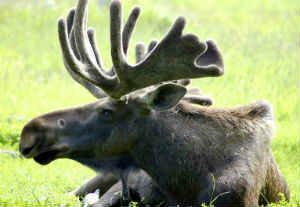
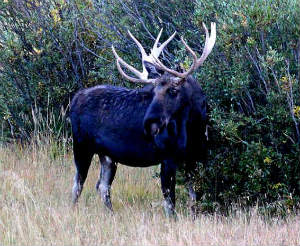 (Enlarge)
(Enlarge)